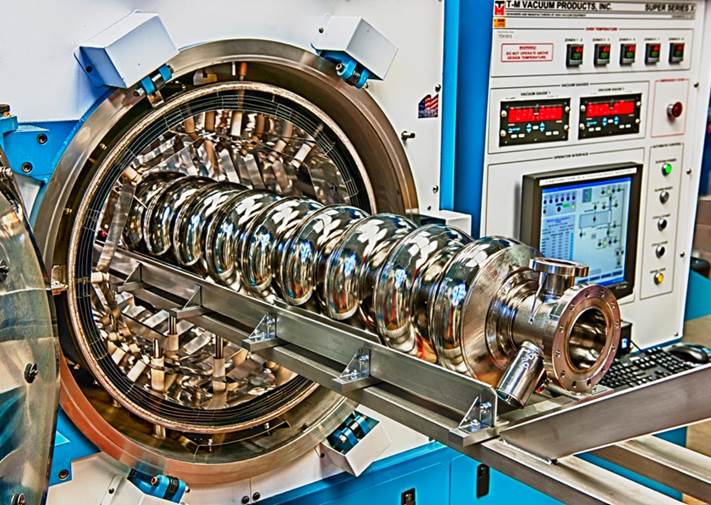Advanced Technology R&D
Image courtesy of Fermilab.
Advances in superconducting radiofrequency accelerator technology may lead to significant cost reductions in operating mid-term future machines.
To keep scientists on the threshold of discovery, HEP fosters cutting-edge research in the physics of particle accelerators, particle beams, and particle detection as part of the Advanced Technology R&D subprogram. Efforts in Advanced Technology R&D can be grouped into three broad categories, based on the general time scale for potentially making use of their output. Near-term R&D is often directed at improving existing facilities or technologies to support current DOE projects. Mid-term, facility-inspired R&D focuses on advancing certain concepts or technologies in order to demonstrate their feasibility and engineering readiness for use in future projects. Long-term, proposal-driven research advances the fundamental science underlying particle accelerators and beams and aims to make transformative breakthroughs in machine size, total cost, and particle beam energy, intensity, and control.
Researchers performing near-term R&D seek to advance the technology in use today to improve current facilities, projects, and experiments. The Proton Improvement Plan is being implemented at Fermilab in order to increase the intensity of the proton beam, which will allow all experiments using the Fermilab Accelerator Complex to improve their operations and collect more data. The Large Hadron Collider Research Program (LARP) continues to leverage U.S. expertise in superconducting magnets in order to design accelerator components that will allow the Large Hadron Collider (LHC) to reach its full potential as a discovery machine.
Image courtesy of LBNL.
Today’s technology would require a 200 meter long accelerator to achieve the same energy beam as this 9 centimeter laser plasma accelerator module.
Mid-term R&D activities allow researchers to find ways to create new or improve existing technologies for use in upcoming planned experiments. Researchers are currently exploring and refining the technology that will provide the foundation for the upcoming international Deep Underground Neutrino Experiment (DUNE) at the Long-Baseline Neutrino Facility (LBNF), the first U.S.-hosted international megascience facility. DUNE will explore the matter-antimatter asymmetry in the universe by using technology based on liquid argon to detect neutrinos and precisely measure their properties. Liquid argon technology offers very high detection efficiency for neutrino-induced interactions, excellent background rejection power, and the capability to distinguish between certain particle types that is not possible using water-based detector technology. Current and near-term neutrino experiments will use liquid argon neutrino detectors to advance neutrino science while serving as an R&D platform to further the technology for DUNE. Investing in this technology now will enable the greatest chance for discovery in the future global neutrino program.
Long-term R&D investments aim to address the critical need for technical breakthroughs that will yield improved detectors and more cost-effective accelerators that could be transformative in both science and industry. Laser-driven plasma wake field technology may be able to shrink the length of a particle accelerator by a factor of 2,000 or more, significantly reducing the size and cost of infrastructure needed to support a future high-energy machine. Advances in high-field magnet technology could similarly enable a leap forward in discovery science while benefiting partners in medicine and industry.
Advanced Technology R&D supports experiments and facilities that further the science and enable discovery. The High Energy Physics Advisory Panel (HEPAP) advises the DOE on Advanced Technology R&D program status and direction.






